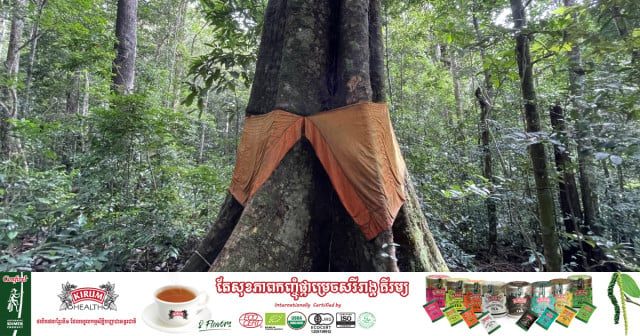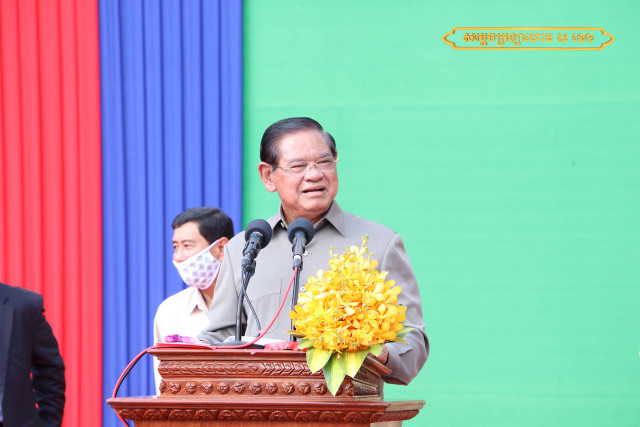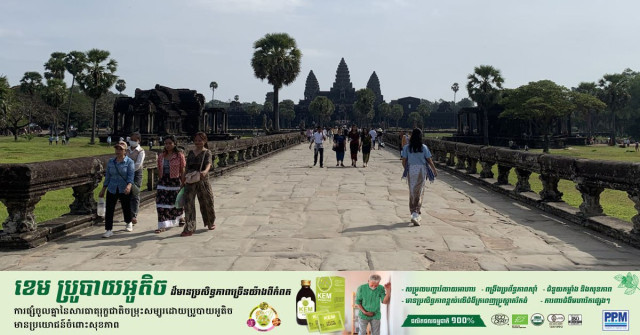Restored Indigenous Rights Will Lead to Better-Conserved Forests

- By Rithy Bun
- September 17, 2023 5:08 PM
Cambodia has roughly 276,000 Indigenous peoples, making up 1.4 percent of Cambodia's population. These people are primarily from 24 unique groups—each with their language and customs.
Many of the Indigenous communities in Cambodia are primarily concentrated in the northeastern region of the country, areas which were previously covered by dense forest.
These Indigenous peoples identify as descendants of forest caretakers and have lived on their ancestral lands for thousands of years. Throughout this time, Indigenous communities have maintained strong ties with the forests in which they live through vibrant spiritual and cultural practices.
These Indigenous peoples have traditionally managed almost 4 million hectares of land and still rely heavily on traditional methods for hunting forest animals, harvesting non-timber forest products, including collecting honey and resin, and conventional rotational slash-and-burn rice farming methods.
Indigenous communities engage in a non-capitalist and non-competitive economy. Indigenous food production and livelihood maintenance methods have gone hand in hand with protecting the forests, mountains, lakes, and rivers that these communities honour as spirit gods and sacred places.
When it comes to the future of Cambodia's forest management strategies, we should look to Indigenous-led, community-based methods, not just because these methods are suitable for the well-being of these communities, but also because these methods have proven time and time again to be better for the health of our forests.
The status quo
Over the past decades,
Nevertheless, at the same time, under these legal frameworks, much of Cambodia's forested areas have been carved up by economic land concessions (ELCs) granted by the government to foreign and domestically-owned private companies in various sectors. Under the 2001 land law, these companies could lease up to 10,000 hectares for up to 99 years. Human rights monitor Licadho states that at least 297 local and international agri-business companies have been granted ELCs covering more than 2.1 million hectares of land.
The companies that have obtained ELCs have used the land for a variety of purposes: for agriculture, for hydropower construction, for mining operations and more. Many of these projects have been carried out in traditional Indigenous territories and natural resource hubs, including sites considered culturally significant and sacred by these communities.
Research found that these ELCs have had an outsized impact on deforestation. Although ELCs contained roughly 16 percent of Cambodia’s forest cover as of 2016, forest loss within ELC boundaries accounted for nearly 30 percent of the country’s total forest loss.
The loss of this land has had negative consequences for these Indigenous communities, threatening Indigenous sources of income, causing landlessness and, perhaps most significantly, leading to the loss of religious practices.
In 2012, Prime Minister Hun Sen issued an immediate and indefinite moratorium on new land concessions and promised a full review of existing ELCs.
Despite this moratorium, new ELCs have been granted as of 2022, one to a local tycoon’s company for 4,000 hectares and another that appears to comprise more than 9,000 hectares to Korean company Horizon Agriculture Development Co. in Steung Treng province. While it is still being determined what company oversees this land, satellite imagery shows that large chunks of forest in this ELC have been cleared since the land was signed over.
Forest and rights advocates have long argued that these ELCs are not just damaging in terms of their impact on the livelihoods and ways of life for local communities and in terms of the conflict they create but that they do not deliver on their economic development promises, not generating nearly enough financial benefit to offset the environmental and social costs they generate.
There is a better way.
It is still possible to restore the rights of Indigenous communities while saving this land's biodiversity, ecosystems, and forests. The best path forward is to expedite communal land registration for Indigenous peoples and to enforce these rights on the ground. These significant steps will also pave the way for the Kingdom to move closer towards reducing greenhouse gas emissions, limiting global warming below 1.5 degrees Celsius as stated in the Paris Climate Accords (2015) and enabling Cambodia to reach the Sustainable Development Goals by 2030.
Communal land tenure works
Communal land recognition is of the utmost importance for the health and well-being of Indigenous peoples. This system forms a significant part of what enables these communities to keep their cultures alive.
Nevertheless, it is also crucial to note that Indigenous land management systems have the potential to be transformational when it comes to protecting this country's forests. Research around the globe has found that this type of forest management—decentralized and in the hands of local communities—has been incredibly successful at enabling forests to thrive.
For instance, research from Columbia, cited by the UN's FAO, shows that forests collectively managed by Indigenous and tribal communities have been conserved better than other forests.
There are various reasons why this type of forest management is particularly effective. Indigenous cultural and ecological knowledge is central to these reasons, rooted and intertwined with Indigenous religious practices. This knowledge translates to better outcomes for forests.
"Indigenous and tribal peoples' traditional knowledge about fauna and flora and their uses, pests and diseases, fire, climate, and soils, and how these elements respond to human practices, contribute greatly to forest management, use, restoration, and monitoring, and adaptation to new situations," FAO explains.
Alternatively, even more simply, "People who spend more time in the forest and know how to get greater benefits from them take care of them better."
Community management of forests elsewhere has also proved successful. Recently released research in Nepal, made possible by remote sensing technology from NASA [U.S. National Aeronautics and Space Administration], found that a 1993 legislation that handed over management and user rights of forests to community forest groups has since led to a near-doubling of forest cover in the country, from 26 percent to 45 percent.
"Once communities started actively managing the forests, they grew back mainly due to natural regeneration," said Jefferson Fox, the principal investigator of the NASA Land Cover Land Use Change project.
As of 2021, 34 percent of Nepal's forests were managed by more than 22,000 community-forest user groups. Under the rules set out by Nepal's legislation, local forest rangers work with community groups to develop plans to manage the forests. Local communities have created projects that allowed the extraction of resources from the forests, like fruits and traditional medicines, and allowed the sale of non-timber forest products. Community members were also empowered to protect forests through local forest patrols.
At the same time, Nepal has shown that natural forest protection can be parlayed into significant economic outcomes, partly through financing initiatives tied to the health of the country's forests. One project linked to sustainable forestry in Nepal has the potential for up to $45 million in support and another $24 million.
Strengthen Law Enforcement on the Ground
In Cambodia, Indigenous community members have long been participating in and advocating for greater control over forests to carry out their vision of sustainable forest management. However, so far, Indigenous-led forest protection initiatives have often had to take place in an unofficial capacity.
For example, Indigenous community members participate in unofficial patrols of their home forests to prevent illegal logging and fire.
Ruos Lim, a Kuy Indigenous leader from Chom Penh forest, part of the 242,500-hectare Beng Per Wildlife Sanctuary, told Mongabay, "Day and night, we will lead our children and grandchildren to protect our livelihoods from all intruders," adding later in the conversation, that "[i]n reality, we are the only active patrollers here."
While Indigenous communities technically have access to legal, communal land titles through the 2009 Sub-decree No. 83 on registration procedures of indigenous communities, in reality, it is not that simple. The road to the collective land registration process can be complex, lengthy and expensive. From 2011 to 2021, only 33 communal land titles have been granted to 33 indigenous communities of a total of 458 Indigenous communities.
It is also important to note that the Indigenous communities are not the only groups impacted by land and forest loss. Aid groups estimate that more than 770,000 people have been involved in land conflicts between 2000 and 2014 alone. This estimate may not even include communities struggling with long-standing land disputes, such as those in Mondulkiri, Ratanakiri and Preah Vihear provinces.
Cambodian laws and the court system have provided few opportunities for relief, causing Indigenous communities to lose hope in judiciary-based and state-based solutions. "We cannot depend on the law; it is too slow," says Kuy Indigenous leader Ruos Lim.
To guide Cambodia on a more sustainable track, the Ministry of Land Management, Urban Planning, and Construction should expedite collective land registration for Indigenous communities and act in accordance with Prime Minister Hun's recommendations made in December 2022 during the Ministry of Land Management's annual meeting regarding a complete land registration system.
Second, the Ministry of Environment should expand the protected areas in Indigenous territories and allocate more funding to support the protection of these forests. The Royal Government of Cambodia should incorporate culture, ecological knowledge and spiritual belief into law, policies and decentralized forest control with communal land managed by indigenous communities.
Finally, legal systems must strictly adhere to court procedures and ensure that the Land Law and ELCs Sub-degree are used to deliver justice and compensation for Indigenous communities. By doing so, Cambodia’s forests will flourish, Cambodia will be less vulnerable to climate change, and Indigenous peoples will have access to prosperity, happiness, and forest stability for generations to come.
Rithy Bun is a research fellow at Future Forum and has many years of experiences working with indigenous communities















